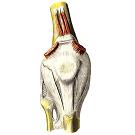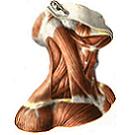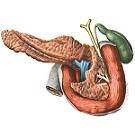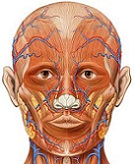Parietal bone
The dark bone , os parietale, the steam, forms the upper and lateral parts of the cranial vault. It has the shape of a quadrangular, convex outward plate, in which two surfaces are distinguished: the outer and the inner - the four edges: upper, lower, front and back. 
The outer surface, facies externa, is smooth and convex. The site of the greatest bulge of the bone is the parietal tuber, tuber parietale. Below the parietal hillside there is an arcuate rough upper temporal line, linea temporalis superior, which starts from the anterior margin of the bone and, as a continuation of the same line of the frontal bone , extends through the entire surface of the parietal bone to its posterior corner. Below this line, parallel to the lower edge of the parietal bone, there is another, more pronounced lower temporal line, linea temporalis inferior (the first is the attachment site of the temporal fascia, fascia temporalis, the second is the temporalis muscle , m. Temporalis).
Internal surface, facies interna, concave; On it there are weakly expressed imprints of the relief of the adjacent brain in the form of finger impressions, impressiones digitatae, and tree-like branching arterial grooves, sulci arteriosi (traces of adjacent branches of the middle meningeal artery , a. Meningea media).
Along the upper edge of the inner surface of the bone is an incomplete groove of the superior sagittal sinus, sulcus sinus sagittalis superioris. With the same name of the furrow of the other parietal bone, it forms a complete furrow (a process of the dura is attached to the edges of the furrow - the crescent of the large brain, falx cerebri).
In the back of the same upper edge of the bone is a small parietal opening, foramen parietale, through which the branch of the occipital artery to the dura mater and the parietal emissary vein pass. In the depth of the sagittal sulcus groove and next to it (especially on the parietal bones in old age) there are many small dimples of granulation, foveolae granulares (here come the outgrowths - granulations of the arachnoid membrane of the brain).
On the inner surface, at the posterior corner, parietal bone lies the deep sigmoid sulcus, sulcus sinus sigmoidei (impression of the sigmoid venous sinus of the dura mater). Ahead of this furrow passes into the eponymous furrow of the temporal bone , posteriorly into the furrow of the transverse sinus of the occipital bone.
Upper, sagittal, margin, margosagittalis, straight, strongly serrate, longer than the rest, joins with the same name of the other parietal bone in the sagittal suture, sutura sagittalis. Lower scaly margin, margo squamosus, pointed, arched; Its anterior part is covered by the posterior part of the upper edge of the large wing of the sphenoid bone; Up to the back of the pego is superimposed by its parietal margin of the temporal bone scales; The posterior region is joined by denticles with the mastoid process of the temporal bone. Accordingly, three seams are formed in these three sections: the scaly seam, sutura squamosa; Parieto-mastoid suture, sutura parietomastoidea, and sphenoid parietal suture, sutura sphenoparietalis.
Anterior, frontal, margin, margo frontalis, serrate; It joins with the parietal margin of the scales of the frontal bone , forming a coronal suture, sutura coronalis.
The posterior, occipital, marginal, margo occipitalis, serrate, connects with the lambdoid margin of the occipital bone and forms a lambdoid suture, sutura lambdoidea.
Correspondingly to the four edges of the parietal bone has four corners, the anteroposterior frontal angle, angulus frontalis, is approaching the direct (limited by the coronary and sagittal sutures).
Anterior narrow wedge angle, angulus sphenoidalis, acute (limited by coronary and sphenoid-parietal sutures).
Posterior occipital angle, angulus occipitalis, blunt (limited by lambdoid and sagittal sutures).
The posterior mastoid angle, angulus mastoideus, is more obtuse than the posterior surface (limited by lambdoid and parieto-mastoid sutures); Its front portion fills the parietal notch, incisura parietalis, the temporal bone.
You will be interested to read this:









Comments
When commenting on, remember that the content and tone of your message can hurt the feelings of real people, show respect and tolerance to your interlocutors even if you do not share their opinion, your behavior in the conditions of freedom of expression and anonymity provided by the Internet, changes Not only virtual, but also the real world. All comments are hidden from the index, spam is controlled.